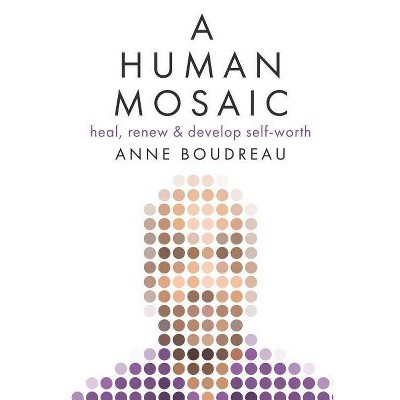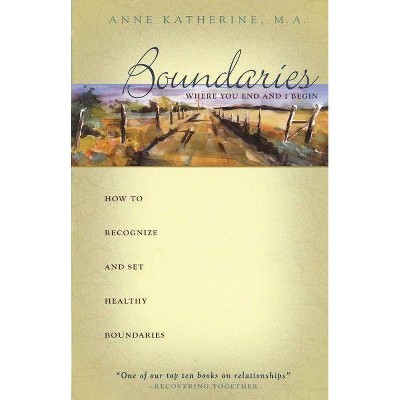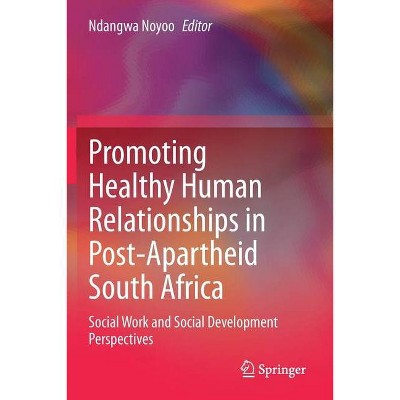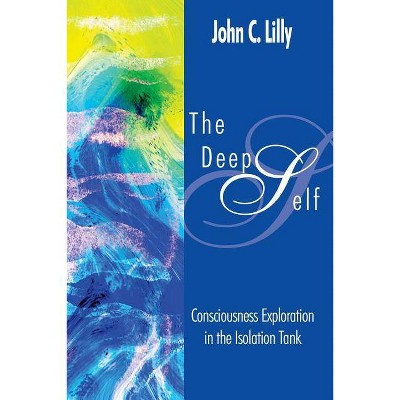Boundaries in Human Relationships - by Anne Linden (Paperback)

Similar Products
Products of same category from the store
AllProduct info
<p/><br></br><p><b> About the Book </b></p></br></br>Delving deeply into the meaning of boundaries and the practical skills and tools necessary to use boundaries, readers will learn to understand exactly what boundaries are, recognize when they are needed, and how to create and maintain them. These skills will give readers choice and control over their emotions, behavior, and thinking.<p/><br></br><p><b> Book Synopsis </b></p></br></br><p>Boundaries are what keep us separate from other people. But they also connect us to them. Being able to manage the boundaries in our relationships enables us to stay fulfilled, happy and productive, and move beyond our psychological and emotional blocks. <i>Boundaries in Human Relationships</i> delves deeply into the meaning of boundaries, how to manage them and provides the practical skills and tools necessary to use them to our advantage.</p> <p> You will learn to understand exactly what boundaries are, recognise when you need them and how to create and maintain them using three simple skills: </p><ul> <li>a clearly defined structure of boundaries </li> <li>specific practical steps for creating and managing boundaries - with examples and exercises </li> <li>an in-depth exploration of the significant areas of relationships and self-esteem through the lens of boundaries. </li></ul> <p> <br> The most important distinction anyone can ever make in their life is between who they are as an individual and their connection with others; Can you truly love another and be the whole, complete and unique person you are? How do you know the difference between your fear and your partners' fear? Or between your past anger and your here-and-now anger? The answer is boundaries and this is a practical guide to unlocking these mysteries.<p/><br></br><p><b> Review Quotes </b></p></br></br><br><p><em>Boundaries in Human Relationships: How to be Separate and Connected</em> is written by Anne Linden. With her vast knowledge of psychotherapy along with neuro linguistic programming, she talks us through the importance of boundaries, how we can set them and the benefits of doing so.<br /><br />As well as describing what boundaries are, Anne also talks about the effects of having no boundaries, when we merge completely with another persons thoughts and feelings as though they were our own, and when we put up walls to block emotion. These different perspectives are talked about throughout the book, which gives a comprehensive view of the different topics discussed.<br /><br />This book increases our awareness of walls and boundaries, showing us how both are useful in various situations and contexts. It helps us to understand that sometimes it can be a good thing to lose our boundaries- (e.g. when watching a film or reading a book) or to put up a wall when dealing with trauma. <br /><br />We learn about the natural development of boundaries and how childhood influences our boundary settings as adults. This book may help parents to understand how important it is to set boundaries for their children. Using real life examples, Anne illustrates complex ideas and concepts, helping the information to sink in. There is an interesting example of how parents can lose boundaries: a 10 year old girl has thoughts of wanting to beat up her brother as he is always calling her names and won''t let her go to the park. When the child expresses this to her parents they punish her for thinking such a thing. Anne describes how parents can lose their boundaries when they behave as though the child acted on her thoughts. This means that they have missed the opportunity to explain to her that her brother needs his own space, and although she was having these thoughts it was wrong to do anything to her brother. Explaining the difference between thoughts and behavior to a child helps to set boundaries. <br /><br />Due to the importance of setting boundaries in therapy, this book highlights some of the issues clinicians come across and offers some useful ideas on how to get through these issues. Chapter nine talks about our identity and how there is a thin line between wanting to help our patients and needing to help them due to basing our identity only on our jobs. She asks the question: as therapists are we helping the patient for their benefit or for our own? Anne describes a situation of a patient who is not improving. A therapist may start to feel low about this. If our sense of self is based on making our patient feel better rather than accepting that we can only do so much for them, then we have lost our boundaries. In order to overcome this Anne describes ''fair witness'', a state that we can develop to restore balance.<br /><br />When we are setting boundaries or have a lack of them we can experience various emotions. I liked the way Anne classifies emotions into inappropriate and appropriate rather than right or wrong. It helps us realise that our emotions are important messages. Rather than ignore or deny emotions we need to see them as a message. If we feel low it may be a sign that we need to change something about our life, or a feeling of inadequacy may be giving us the message that there is an opportunity to learn.<br /><br />To help us understand the information, Anne sets many practical exercises ranging from written tasks, meditation and ways to become more aware of our physical sensations. I particularly liked the exercise in chapter six: noting similarities and differences in situations. Anne explains that if we only ever focus on all the differences between us and someone else then it can be difficult to form a close relationship as there is no connection. We can end up putting up a wall. Similarly, if we only focus on how we are the same as someone, we are losing our boundaries. We may become too similar to someone else and could feel threatened by change. <br /><br />The ideas and concepts explained in this book are very complex and analytical at times. I found that when I applied my own examples to her ideas it made it easier to understand. However those without psychological knowledge and awareness may struggle to do this, or may not be able to understand certain sections of this book. This is a difficult book to read alone and people may benefit more from discussing some of the ideas with a friend or even progressing further with counseling. It is best to progress through this book gradually, as some paragraphs need to be read more than once to fully grasp the information.<br /><br />There are lots of practical exercises recommended in the book and to get the most out of this text a lot of time and motivation will be required. For someone new to this subject this book may be too overwhelming. It is best suited to those who already have some background knowledge but are looking for a richer and more in depth understanding.<br /><br />Although this book is challenging at certain points, I found it very interesting. Boundaries in Human Relationships gives us more understanding about our personality, our identity and self esteem and how our childhood can be useful to look back to when we are trying to understand boundaries as adults. This book really made me think and analyze myself and has given me a new awareness in this area as well as some useful ideas and skills to apply to my life. </p><p>Metapsychology</p><br><br><p>Anne Linden does it again!. A clear complete analyses and description of Boundaries in human behaviour that is accessible to professionals and the average reader both. As in her previous works on the practise of Neuro Linguistic Programming, this new work, <em>Boundaries in Human Relationships - How to be Separate and Connected</em> is both theoretical and practical. <br /><br />Through methodical exposition and inspiring examples including personal practise exercises you come away with a great deal of revealing and useful imformation.<br /><br />The book is sprinkled with fables and ''stories'' that further add to the depth of the message.<br /><br />Anne Linden is for real!</p><p>John Fischer</p><br><br><p>Anne Linden has handled her challenging, paradoxical subject of boundaries with enormous skill, clarity and understanding, She has made these invisible structures in our human relationships visible and easy to read.<br />Using a light touch she lets us see ourselves in her stories and metaphors which are humorous, suspenseful and deeply human.<br /><br />Thanks to her work after thirty years of practice I finally understand about boundaries -- that they are ubiquitous and weave themselves into every aspect of our lives.<br /><br /> With this very wise book, Anne Linden has broken new ground.<br /><br />It gives us a whole new way to think about boundaries and can be read and reread many times.</p><p>Jane A. Parsons-Fein</p><br><br><p>Anne'' writes, Boundaries are the most basic and fundamental element of any functioning relationship. This easy-to-read, delightful and informative book will guide and counsel you about this essential element, never before written about with such wisdom.<br /><br />A must for teachers, NLP trainers, and Therapists as well as lovers and parents, it will become your user''s guide to successful relationships.</p><p>Susi Strang Wood</p><br><br><p>Boundaries are invaluable for any relationship, and the key to having the most healthy relationship possible. Boundaries in Human Relationships: How to be Separate and Connected is an informed and informative treatise that can help readers relationships by encouraging them to set forth healthy boundaries with them and their partners, to make each of them more complete people on their own to unlock a more complete love between both of them. Boundaries in Human Relationships: How to Be Separate and Connected is a deftly researched and composed piece of work, and is highly recommended for community library psychology shelves everywhere.</p><p>The Midwest Book Review</p><br><br><p>Boundaries are that intangible distinction between our inner and outer worlds, between ourselves and others. These distinctions create separation and yet, are permeable, allowing people to exchange emotions and information. In her latest offering, <em>Boundaries in Human Relationships: How to be Separate and Connected</em>, author and NLP trainer, Anne Linden explores the subject of human psychological boundaries and how to manage those boundaries in a wide variety of contexts.<br /><br />Boundaries allow for both separation and connectedness. When boundaries are too rigid, they become walls, preventing empathy and connection. Conversely, weak boundaries result in a loss of a sense of self. For those with imbalanced boundaries, separateness means loneliness and connectedness means suffocation. Linden writes: <em>The purpose of boundaries is to enable you to know and understand yourselfas separate and unique from others, while connecting with them; you can be a part of the world, allowing the world to touch you as you remain distinct from the world. The purpose of walls it to protect you from the world, from being overwhelmed by the emotions of others, by situations that are dangerousThe purpose of no boundaries is to give up all distinctions and separation and lose yourself in another, to merge with nature or a situation that is gratifying, satisfying and enjoyable. (p. 15) </em>Linden''s thorough treatment of this topic makes for enlightening reading. Often, our boundaries constitute defense mechanisms against feeling abandoned or controlled by others. It is our continuing challenge to distinguish between self and other. Linden also advises that we make distinctions between thinking and doing, the part and the whole, identity and description, as well the past, present and future. Making all these distinctions relies on maintaining and managing boundaries. To do so, we continuously adjust our boundaries according to contextual variables such as place, people, activity, time, and gender. Linden tells us: <em>Contextual boundaries help you to be more flexible and have more choices; your more congruent with your environment, show yourself in the most positive light, and your resources are more available to you. (p. 73)</em>The book analyzes and explains the cognitive and perceptual patterns that support boundaries: <ul><li>Ego Strength: Our likes, dislikes, and values give us a separate sense of self. <li>Self in Process: Experiencing the self as an evolving work in process, we see ourselves as in all facets, as individuals with a past, present, and future. <li>Empathy: By vicariously experiencing another''s emotions, we understand and connect with them.<li>Noticing Difference: Our ability to make distinctions, compare and generalize allows us to know the world around us and understand what makes each person and event unique.<li>Observer Self: When we take an observer view of self, we understand more about how we relate to others and how others perceive us. </ul>We create and maintain boundaries through three skills: 1) simultaneously recognizing sameness and difference; 2) connecting to the body and using it as a physiological filter of experience and 3) using peripheral vision and peripheral hearing to pay attention to the background, while focusing attention on the foreground. These skills help us to more accurately assess the environment and how we interact with it. With such skills, we minimize distortions and make better decisions about who we are, what we''re capable of, and what the world is. <br /><br />Ms. Linden discusses the implications of boundaries in a wide variety of human relationships such as teacher-student, therapist-client, parent-child, managers and employees, colleagues, and lovers. She also looks at boundaries within the self. She examines how we connect with the parts within ourselves and negotiate with these sub-personalities. I was especially taken with her description of a change agent as a FAIR WITNESS one who is caring, yet objective, without attachment to others'' outcomes, without the need to help, heal, or fix, yet fully present and holding the other in positive regard. Linden proposes that we act from this perspective when negotiating among our parts. <br /><br />Linden ends her book with an astute discussion of issues related to identity and self-esteem. She teaches us how culture and experience shape identity, beliefs, and self/world concepts, and these, in turn, influence our boundaries. Her Identity Ritual and Identity Meditation help readers have a concrete experience of identity. Similarly, she guides her readers in an understanding of the many facets of self-esteem, with the message that the self is constantly evolving. By learning to manage our boundaries, we come to accept our emotions and expectations, we learn to love ourselves and find a personal life mission. <br /><br /><strong>Conclusion</strong><br /><br />Anne Linden directs the New York Training Institute for NLP and is one of the most highly-respected trainers in NLP. She has written two other excellent books: <em>The Enneagram and NLP</em> (Metamorphous Press, 1994) and <em>Mindworks: Unlock the Promise Within</em> (Andrews McMeel, 1997), both well-received by psychologically-minded readers worldwide. I had the delight to interview her in 2004 for <em>Anchor Point</em> magazine and it is a distinct pleasure to review this book. <br /><br />What is worthwhile about this book is the way in which the author helps readers to so completely understand a process that usually operates at the non-conscious level. She gives her readers the skills and tools to make informed decisions about when and where to increase or decrease boundaries with others and within the self. <br /><br />While Ms. Linden does not cite other authors who have written on this subject, and does not draw upon research studies, she does bring to this book over 25 years of experience in working with human relationships as an accomplished trainer, advisor and consultant. Linden''s writing has a familiar, personal feel, with the tone of a friendly, insightful mentor. She peppers each chapter with real-life examples and teaching tales to bring home her main points. She includes self-help exercises, useful for the individual reader, or a trainer working with a group, or a coach or therapist making an assignment for a client. <br /><br />This is a book for anyone who wants a better understanding about this often-ignored aspect of human relationships and provides valuable information for therapists and coaches who work with clients having boundary issues. The information applies to situations we encounter every day. Read it and you could acquire a deeper understanding of yourself in relation to those around you, and expand your flexibility in truly being comfortable with others, while maintaining your own unique individuality. Anne, thank you for yet another gem! </p><p>Judith E. Pearson, PhD</p><br><br><p>I can think of no more timely and urgent subject for the success and health of Life on Planet Earth than that of Human Boundaries.<br /><br />Anne Linden''s new book, <em>Boundaries in Human Relationships</em>, is a much needed and wonderful contribution to this field, and it gets better each time I read it. Not only will it give you lots to look at and think about, it gives you ways to practice establishing your own boundaries that are simple, clear and effective. It is full of detailed information about the different types of boundaries, their structure, and their psychological developmental underpinnings, as well as many examples of how these boundaries are experienced in daily life.<br /><br />To clearly and firmly sense your own boundary is to know yourself. It is the basis of all healthy and loving relationships. And it feels good! Read this book slowly, and then read it again.</p><p>Paul Carter</p><br><br><p>Ideal, for any Social Care Worker, Teacher, Therapist, Social Worker, or Energy Worker, who is having negative issues from others spilling over into their personal space. This book focuses on the topic of managing the emotional space between clients and professionals. The space that keeps you separated and dis unified or connected and whole, happy and safe.<br /><br />If you are feeling frustrated from taking on your clients stresses, and worries, you will want to learn to create habits and behaviours that match your desires for peace, calm and tranquillity. Living without their stresses. It guides the practitioner how to live without clients stresses. So this book really teaches you to live as a practitioner working with highly explicit situations, whilst still maintaining your own personal space of calm, peace and tranquillity. <br /><br />The big vision, which Linden encourages you to practise and experience as on its way, is your biggest most inspirational personal dream. She does that because it will fill you up with a great wonderful energy. She acts as a positive conduit by affirming how possible it is for you to be in a state of gratitude for yourself. To find yourself as important, just as you are now. Without having to be improved or to change. To know you are valued just as you are now. And to do something for someone else, whoever it might be and then to affirm yourself as a clear space, filled with the sorts of positive energy you want to hold in your energy space. She teaches you to put a picture in your breathing space of exactly the sort of energy you most want in your personal space you are asked to create the exact sort of energy you want to between you as you interact with them. The book teaches you to extend into your own inner and deeper space, an area of what you most enjoy to master, as you are the only one who has the keys to creating and maintaining its energy. <br /><br />The book draws out 8 main principles for the reader. Threading these 8 strands into a clear usable picture, Linden, is inspirational at fleshing out exactly the nature of how interpersonal boundaries are organized. <br /><br />The chapters on boundaries, internal and external boundaries, self and other boundaries, contextual boundaries, patterns necessary to support boundaries, doing boundaries, boundaries and relationships, boundaries and parts, boundaries and identity, boundaries and self esteem. Makes this a powerfully helpful book, practical, based on many years of case studies, about relationship with others and with self. <br /><br />Inviting the reader to experience their deep range of resources, she acknowledges that its being able to hold the issues around being separated and connected at the same time which will provide human relationships with the greatest boost. She provides clear tips and guidance around accessing and activating those inner personal resources, be they attitudes, aptitudes, skills, or interests. Writing in a thought-provoking style. She uses case studies, painting metaphors, which acknowledges that, the wood of the tree may have great beauty, but unless the carpenter has skill the beauty remains hidden. She directs the reader to uncovering the inner rich resources found in a persons attitudes, aptitudes, as well as skills and final outcomes. She teaches you how to find treasure and riches in an attitude, and most exciting she teaches you to utilise what ever you are starting with, so you do not need to be any thing else special. Just as you are, is exactly how she wants you to be. <br /><br />Some readers in the practise of imagining the worst may find this book deliciously challenging. Linden, directly and indirectly asks the reader to bring out ones inner resources and bring them to the surface to be used. She bravely writes about the misfortune a person may experience if are unable to acknowledge their own inner talents. <br /><br /> Be prepared to explore the most positive, enjoyable, pleasurable images you can conjure up and maintain for yourself. Be prepared as you read to practice how you create your own ways of placing those exquisite feelings into the gap, place, opening, area between you and your client as you deal with some of the most difficult situations. You will be taught how to breathe into your own breathing space, re filling it up with reassuring emotions that you generate from yourself. Breathing and letting go is core to this books power. <br /><br />By combining, NLP processes of clarification, she encourages the reader to assess where and what you draw your own resources of upliftment from. Over and over again, she helps the reader clarify what it is that flows over and through your life that acts like water to wash away the worries or hurts that, if left in place would gradually produce a sickness of spirit. With the tone of someone who really cares about her reader she reinforces how without it you could not drink. How without this regeneration your life would be dry. A lovely text that asks gently nudges you to build your worldly activities around what best nourishes you, much, like an ancient city around its central well. Magnificiently, it could be called major parts integration manual. Each chapter deepens the readers unconscious skills into playing, renewing and strengthening, the freedom to live another day free of the defeating emotions, that exist in between the spaces between different parts of themselves. This book is acts a guide to your own personal internal wellspring. Helping you to make sure that the inner jug with which you draw the precious fluid from this well is sound and cared for. This comes from using all the techniques to experience how you started of as one, unified whole<br /><br />Linden is a writer, who takes the reader far beyond fashions, which come and go. Yes, she uses familiar NLP techniques to address the fundamental needs and facts of life that remain the same. How you are relating to parts of yourself, and how do you do that. Through human co-operativeness. Co peration within yourself. Co operation between parts of yourself. So you act as one unified whole! <br /><br /> A fundamental text, Linden describes clearly how to work with the 8 principles, equipping people workers with effective guidance in dealing with the spaces between their relationships. <br /><br />Highly recommended. </p><p>Deborah Rose</p><br><br><p>Relationships can be fraught with boundary disputes. This book attempts to show the reader how to draw boundaries clearly.<br /><br />Plainly written, easy to understand and easy to use, Ms Linden teaches you how to maintain and improve relationships through the use of boundaries. This book is very useful for therapists, teachers and people in general. We could all use a little help with boundary keeping, and this is a good way to start.</p><p>Terri Bodell</p><br><br><p>There are few detailed texts about the specific nature and application of ''boundaries'' within therapeutic relationships and this title is a welcome addition to the literature. <br /><br />Within 10 concise chapters the author provides a lot of helpful information for both novices and experts in the field and the stories and anecdotes are illuminating and deepen our understanding of the issues.<br /><br />The author explores a range of theoretical issues relating to the nature of counselling, self-awareness and maps the NLP counselling process. As the book introduces the basic theoretical and practical skills essential for all health care professionals, potentially it has a wide professional readership.<br /><br />The author highlights potential pitfalls in the counselling relationship and explains clearly how we might overcome these and understand more about ourselves and the needs of others.<br /><br />The emphasis upon empowerment and fostering ontological security and self-esteem is refreshing and clearly puts the client at the heart of the counselling process.<br /><br />I would have liked to have seen a reference to the Ethical Framework for Good Practice in Counselling and Psychotherapy from the British Association of Counselling and Psychotherapy but note that the text is aimed at a wide European and Transatlantic market.</p><p>Andy Young</p><br><br><p>This wonderful book by Anne Linden addresses a crucial aspect of human relationships. The writing is very clear, helpful, and meaningful. I believe many people can benefit from reading it.</p><p>Stephen Gilligan, PhD</p><br><br><p>You would think that observing boundaries around other people would be a matter of common sense but reading this book really brought home to me how easy it can be to blunder in without thinking and, perhaps, ruin what could have been a great relationship.<br /><br />Anne Linden shows you how to teach your clients and, for that matter, yourself, to recognize personal boundaries, and those of other people. The author has written a very comprehensive book, covering boundaries in personal, emotional and working life, including a very interesting section devoted to Boundaries and Parts, from which therapists of all levels could learn quite a lot about helping their clients and themselves.<br /><br />An excellent book with much knowledge to impart about the way human beings operate around each other.</p><p>Fidelity</p><br>
Price History
Cheapest price in the interval: 22.49 on October 23, 2021
Most expensive price in the interval: 22.49 on December 20, 2021
Price Archive shows prices from various stores, lets you see history and find the cheapest. There is no actual sale on the website. For all support, inquiry and suggestion messagescommunication@pricearchive.us



















